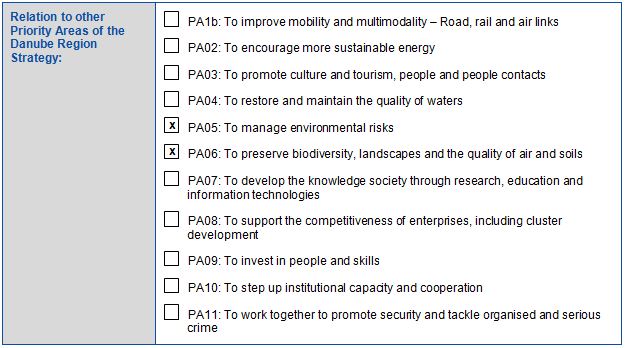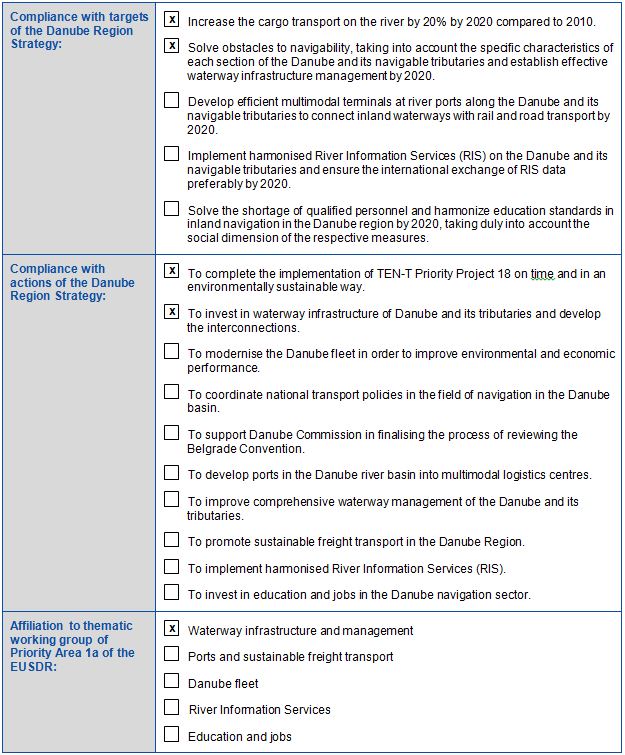BASIC PROJECT DATA
Project ID: PA1A027
Project website: http://www.fastdanube.eu/
NEED AND ADDED VALUE FOR THE DANUBE REGION STRATEGY
On the Lower Danube the width of the fairway is generally sufficient for accommodating multiple ships, but the depths for ensuring the efficient transport of goods are often not sufficient. In low water conditions, vessels sailing on the Danube sector between km 845.5 and km 375 sometimes can be loaded only at 50% of their capacity. These situations lead to serious losses for river transport operators and affect the internal market of transports, in relation with other transport modes and with other alternative routes. Unfortunately, traffic flows affected by these issues are lost for a long time due to the lack of reliability of river transport.
Therefore, projects to enhance navigability, including rehabilitation, infrastructure projects and maintenance, are of crucial importance.
The project FAST Danube will identify appropriate solutions to solve navigability issues on the Romanian-Bulgarian common sector. Removing navigation bottlenecks will lead to low administrative costs, ensuring a good level of services with smaller tariffs, ensuring proper navigation conditions by the river administration with less efforts.
Within the FAST Danube project, an appropriate framework to optimise the Internal Market for Inland waterway transport could be created, helping to remove barriers / bottlenecks that prevent its increased use. This is another important goal of EU policy relative to Internal Market and Transports, in the European context of enhancing a suitable framework for inland navigation. By solving some critical areas bottlenecks on the River Danube as a main European transport axis, the project supports the free movement of goods, one of the “four freedoms” that form the cornerstones of the single market.
This project on the common Romanian-Bulgarian sector has a special importance in terms of ensuring navigation conditions on the Danube. It was selected as a priority project under Axis 18 for the Rhine/Meuse–Main–Danube transport axis, according to Decision 884/2004/EC of the European Parliament and the Council as well as on the Rhin – Danube Core Network Corridor.
With respect to the minimal fairway parameters (depth and width) recommended by the Danube Commission, it should be noted that the least available depth is the predominant factor in the current situation. It affects the navigational conditions as it determines the maximum draught of the vessels and hence the carrying capacity of the fleet.
One of the targets of Priority Area 1a is to solve obstacles to navigability and establish effective waterway infrastructure management by 2020 and the project definetively contributes to it. The increasing of passenger and freight traffic along the inland waterways is a precondition for the renewal of the fleet and increasing of the number of the private transport operators.
OBJECTIVE(S) OF THE PROJECT
The overall objective of this Feasibility Study is to identify technical solutions to be implemented in order to ensure at least minimum fairway parameters for the benefit of safe and efficient traffic on this Danube stretch throughout the year. During the study solutions for each critical section will be identified based on field measurements, hydrological modelling etc. The criteria to select a certain technical solution are: technical and economic efficiency as well as environmental impacts. The perceived impacts on Natura 2000 sites are especially crucial for the development of technically feasible solutions.
The scope of the project is:
- Investigate and develop technical solutions to be included in the feasibility study to ensure stable navigation condition in the Bulgarian-Romanian Danube common section all year round;
- Identification of the future works actions to remove existing bottlenecks;
- Obtaining the EIA and Appropriate Assessment approvals for the works activities to be undertaken in the future;
- Complete the technical specifications for future works actions to be implemented in this section.
PLANNED PROJECT ACTIVITIES
Activity 1 – Feasibility Study
This activity consists of a set of preparatory studies to determine the current status of the Romanian-Bulgarian common sector of the Danube and the feasibility study elaboration. This activity will include identifying future hydro-technical works, the time schedule for the implementation of the project, cost estimation and their implementation methodology, in close liaison with legislative requirements on both environmental protection at national and European level.
Topographical, hydrological and hydrographical measurements and sediments analyses will be performed on the above mentioned section of the river. An analysis of sediments which will need to be removed to prevent interference with navigation and minimise the spread of contaminants to the surrounding environment will be carried out. A mathematical model will be developed and used to test the proposed solutions.
Based on measurements and data analyses it will be proposed at least two alternative scenarios to be tested with the mathematical model. For different scenarios it will be performed the economic assessment and it will be selected the preferred scenario in terms of increased navigability, protection of the environment and economic development.
Activity 2 – The Environmental Impact Assessment
The objective of this activity is to update the EIA report and deliver an appropriate assessment in compliance with the requirements of the EIA Directive and to obtain a favourable opinion from the competent authorities.
The Environmental Impact Assessment of the proposed works includes the study to determine the impact on Natura 2000 sites in accordance with national and European environmental legislation in force, in order to limit the environmental effects and to propose compensatory measures, if necessary.
The EIA procedure includes the initial assessment phase that can be performed in parallel with the surveying activities within the feasibility study for update the current situation of environmental conditions. The updated EIA report will be subject to public consultations. The objective of this Sub-Activity is to undertake an EIA for the selected scenario.
EIA approval process is necessary to obtain a favourable opinion from the competent authorities. Expected deliverables in this process include:
- Notification report: this report is the technical summary of the environmental assessment that will be carried out. It covers the scope of the project and defines the different issues that will be investigated and analysed.
- Minutes of the meetings with the relevant stakeholders to discuss the results of the analyses.
- Submission of the complete EIA dossier to the relevant authorities.
- Official EIA notification.
The professional association and environment organisation will be involved in the project in the Stakeholders FORUM (5 per project) and Advisory Council (2 per year).
Activity 3 – Preparing the Public Procurement Procedure for Design and Construction
The Activity covers the preparation of the technical specifications for the procurement of the final designs and the works actions which were identified in the feasibility study. Expected deliverables for Activity 3 include the publication on the EUOJ of the technical specifications for the contracts to be awarded to undertake the works actions to remove existing bottlenecks in the Bulgarian-Romanian common section.
Activity 4 – Project Management and Communication
This activity comprises all tasks and responsibilities to efficiently coordinate and manage the project. The coordinator of the action, River Administration of the Lower Danube Galati, will be responsible for the project management and for the implementation of the overall project. The project partner (IAPPD Ruse) has to foresee appropriate time (depending on their national procedures) to deliver necessary information to the Coordinator partner (AFDJ Galati).
The Advisory Council is a consultative body and it consists of the relevant stakeholders. It will review the technical solutions before the approval of the Steering Committee. The Steering Committee will be the main decision making platform of the beneficiaries. It consists of the relevant Ministries of the beneficiaries’ countries, the respective River and Port Administrations.
The communication and dissemination activities comprise the provision of a project website, a project folder, organisation of dissemination events and press conferences.
TRANSBOUNDARY IMPACT
Improved navigability on the Danube will have a significant socio-economic impact on the communities from the neighbouring regions. It will determine both an economic impact on transport operations and port operating activities and will be a factor of stability in terms of jobs in the affected areas and relative to socio-economic aspects. Business partners from Romania and Bulgaria will be brought closer together leading to a boost of economic exchanges, commerce and transportation between the two countries. The benefits will exceed the regional level, all Danube riparian countries being positively affected by the removal of navigation bottlenecks.
PROJECT BENEFICIARIES / TARGET GROUPS
Shipping and forwarding companies
STATUS AND TIMEFRAME
Start date: 01.11.2014
End date: 31.12.2020
The project was prolonged. Initial end date: 31.12.2018.
FINANCING
Total budget: 5,252,000 EUR
EU funds: 4,464,200 EUR are funded by the Connecting Europe Facility (CEF) 2014 – 2020
National funds: 787,800 EUR Romanian state budget
PROJECT TEAM
Project leader: River Administration of the Lower Danube Galati (AFDJ Galati) / Romania
(website: www.afdj.ro)
Address: Portului, 32, Galati / Romania
Project partner: Executive Agency for Exploration and Maintenance of the Danube River (IAPPD) / Bulgaria
Address: Slavyanska Str 6, 7000 Ruse / Bulgaria
PROJECT ENVIRONMENT
PROJECT CROSS – REFERENCE
FAIRway Danube (PA1A108), SWIM (PA1A115)
The project is closely interlinked with the SWIM project and FAIRway Danube. Only after the approval of the environmental impact assessment done within FAST Danube, works planned within SWIM may start.
STRATEGIC REFERENCE
- General Transport Master Plan of Romania, approved by the Government Decision no. 666/2016
- The Rhine-Danube Core Network Corridor
- Belgrade Convention (1948)
- Plan of the major infrastructure works, as published by the Danube Commission in June 2014
- Declaration on Effective Waterway Infrastructure Maintenance on the Danube and its Navigable Tributaries (Luxembourg, 7 June 2012)
- NAIADES II Communication 2013 “Towards quality inland waterway transport
- European Agreement on Main Inland Waterways of International Importance (AGN)
- White Paper Roadmap to a Single European Transport Area – Towards a competitive and resource efficient transport system COM(2011) 144 final
RELEVANT LEGISLATION
- Regulation (EU) No 1315/2013 of the European Parliament and of the Council of 11 December 2013 on Union guidelines for the development of the trans-European transport network and repealing Decision No 661/2010/EU
- Regulation (EU) No 1316/2013 of the European Parliament and of the Council of 11 December 2013 establishing the Connecting Europe Facility, amending Regulation (EU) No 913/2010 and repealing Regulations (EC) No 680/2007 and (EC) No 67/2010
- Low no. 203/2003 regarding the guidelines for the creating, development and modernization of transport networkof national and international importance
- All EU Directives related to Environmental Protection
EUSDR EMBEDDING
EUSDR COMPLIANCE
OTHER RELEVANT ISSUES
PROJECT REQUIREMENTS
Funding and an efficient project management in order to cope with all issues likely to occur during the project implementation. As critical issue: Environmental permits and authorization from Romania and Bulgaria.
FOLLOW – UP PROJECT
River engineering design and training works for implementing the technical solution. As potential sources of financing are as follow: National Operational Programme for Transport and Structural Funds.
META DATA
Data provided by: Romeo Soare (AFDJ Galati) – 30.01.2015
Last update by: Monica Patrichi (Ministry of Transport, Romania) – 10.04.2017
Download pdf




